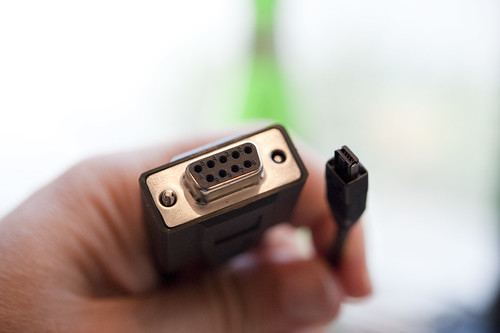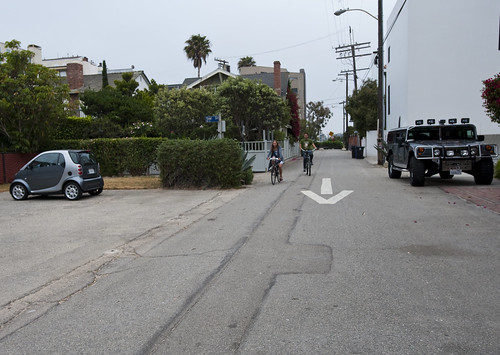A ridiculously quaint DB9 connector attached on the far end to some peculiar, but not-mini-USB connector. (Best as I can tell, the thing on the other end is a proprietary connector, but I’m prepared to be proved wrong. Every of the variety of old and new *scaled* USB connectors I have lying around would not fit into the connector port on the device that is meant to be connected). The grotesque scale difference reminds me of the queasy feeling I get when I stand close to and look up at tall things like grain silos, especially.
The preposterous DB9 is the thing that make me shake my head ruefully and do that sucking of air between my teeth because it came packaged with a 2010 device, which is to say something quite new, freshly produced. It’s a decidedly geeky, quite expensive software programmable wide-band radio. The fact that it is geeky is almost certainly why it comes with a DB9 connector on the *computer* side, rather than a USB connector. Geeks tend to (a) have a *PC* containing at least one old-fashioned RS232 sputting serial port on it, and (b) know how to program things that talk RS232 over the *serial port*. But, then to put some fancy subminiature connector on the *other* end as if to say —
*we’re connecting your creaky, ancient computational device that needs a fan to keep it from blowing up to your fancy, new fuck-off-and-die software programmable radio, and we’re going to link the ancient past with the new, gleaming future — you just need this this special flux-capacitor cable. And, bonus — you can *buy* another cable with a so-called *Universal Serial Bus* connector instead of the *DB9* plastic cudgel if you’re already living in the 21st century.*
G’aaaaahhhh!
Well, although I am intellectually peeved that I am still finding things in the 21st century that contain DB9 connectors on them, what I am intellectually curious about is how, when, why and what becomes *legacy*? How do things such as this enter into the idiom of *quaint*, or *old fashioned*? How long before such things become *obsolete*? What standards, norms, expectations, specifications, technical requirements compel a *holding onto of the past?* What are the scales of historical pasts — retro, old-fashioned, quaint, legacy, plain-old, ancient — and how do they shape design and engineering possibilities for the near future?
Why do I blog this? Attempting to understand how to make the future into today, possibly by making extraordinary things that might come to be into either ordinary or even normal and everyday and then into quaint and old-fashioned. I am curious as to how to play with scales of time to help place things/experiences/moments that might be quite near futuristic into the quotidian, everyday. That is, making the new crazy stuff ordinary so we can begin to explore the kinds of rituals and practices that these things exercise. At the same time, reflecting on how Everything That’s Happened, Has Happened Already — so how do you create those moments that elevate the experiences that are now happening again rather than over-fetishizing the technical and instrumental aspects of the kit?
Continue reading Preposterous Scales of Time and Size


